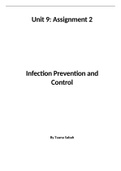Unit 9: Assignment 2
Infection Prevention and
Control
By Tuana Sabah
, (B.P5) Review how successfully use of own techniques prevented and controlled
infection.
(B.D2) justify the procedures and techniques selected and adapted to prevent
and control infection which references to the different situations
During our practical activity on preventing and controlling the spread of infection, we went over
how to safely handle medication, hand washing techniques, use of personal protective
equipment (PPE), sterilizing equipment, cleaning worktops, desks, and beds, and cleaning a
dummy.
Decontamination is a combination of processes that removes or destroys contamination so that
infectious agents or other contaminants cannot reach a susceptible site in sufficient quantities
to initiate infection, or other harmful response. Disinfection and sterilization are essential for
ensuring that medical and surgical instruments do not transmit infectious pathogens to
patients. Because sterilization of all patient-care items is not necessary, health-care policies
must identify, primarily based on the items’ intended use, whether cleaning, disinfection, or
sterilization is indicated. The three main decontamination processes include cleaning,
disinfection, and sterilization. Thorough cleaning is required before disinfection and
sterilisation, because Inorganic and organic materials that remain on the surfaces of clinical
instruments may interfere with the effectiveness of disinfection and sterilisation. Cleaning
removes dirt, dust, large numbers of micro- organisms and the organic matter using detergent
and warm water or disposable detergent wipes. The disinfection or sterilisation process will be
less effective or ineffective if soiled materials are left to dry or bake onto the clinical
instruments. Disinfection is a process of removing or killing most, but not all viable organisms.
Disinfectants are antimicrobial agents that are applied to non-living objects to destroy
microorganisms that are living on the objects. Disinfectants work by destroying the cell wall of
microbes or interfering with the metabolism. The aim of disinfection is to reduce the number of
micro-organisms to a level at which they are not harmful. Sterilization is a process of removing
or killing all forms of viable organisms including transmissible agents such as viruses, bacteria,
fungi, and spore forms. Dead microorganisms and toxins (pyrogens) may remain, however.
Sterilisation can be achieved by applying chemicals, high pressure, heat, irradiation, and
filtration or a combination. Every Health and Social Care service will all clean, disinfect and
sterilise at different times within the establishment. The choice of decontamination method
should be related to the infection risk associated with the intended use of the equipment.
Other factors to be taken into consideration when choosing a method of decontamination
include the nature of the contamination, the time required for the processing, the heat,
pressure, moisture and chemical tolerance to the object, the availability of processing
equipment and the quality and risk associated with the decontamination method. Cleaning is
suitable for low-risk items which touch only intact skin, or which make no contact with the




